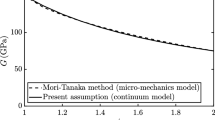Abstract
Many materials that have been developed recently such as titanium alloys and polymeric composites exhibit nonlinear elasticity in the “small” strain regime, and the linearized theory cannot be used to describe the response. Recently, Rajagopal (Appl Math 48(4):279–319, 2003) introduced a new implicit constitutive theory which can be used to develop models to characterize the response of these newly fashioned materials. Here, we study the response of these new classes of elastic bodies within the context of two boundary value problems: the pressurization of a cylindrical annulus and a spherical shell. In the case of the cylindrical annulus, a stress function is introduced that automatically satisfies the equilibrium equation, and the compatibility equation for strain and the nonlinear constitutive equation is used to obtain the nonlinear compatibility equation in terms of the stress function. For the spherical shell, a displacement formulation is used to arrive at a nonlinear equation for the radial stress. The governing equations in both cases cannot be solved exactly, and we use an approximate technique, the variational iteration technique, to solve the problem. We show that this approximate solution agrees very well with the numerical solution of the governing equations, and the solution is different from that obtained in the classical linearized elasticity. In the case of spherical annulus with an internal pressure of 250 MPa, the hoop stress associated with the linearized solution overpredicts the numerical solution by about \(10\,\%\) at the inner radius and underpredicts by about \(7\,\%\) at the outer radius.




Similar content being viewed by others
References
Carroll, M.: Must elastic materials be hyperelastic? Math. Mech. Solids 14(4), 369–376 (2009)
Green, G.: On laws of the reflexion and refraction of light at the common surface of two non-crystallized media. Trans. Camb. Philos. Soc. 7(1), 1–24/113–120 (1837/1839)
Green, G.: On the propagation of light in crystallized media. Trans. Camb. Philos. Soc. 7(2), 121–140 (1839)
Hao, Y.L., Li, S.J., Sun, S.Y., Zheng, C.Y., Hu, Q.M., Yang, R.: Super-elastic titanium alloy with unstable plastic deformation. Appl. Phys. Lett. 87(9), 091906-1–091906-3 (2005)
Li, T., Morris Jr., J.W., Nagasako, N., Kuramoto, S., Chrzan, D.C.: Ideal engineering alloys. Phys. Rev. Lett. 98(10), 105–503 (2007)
Rajagopal, K.R.: On implicit constitutive theories. Appl. Math. 48(4), 279–319 (2003)
Rajagopal, K.R.: The elasticity of elasticity. Z. Angew. Math. Phys. 58(2), 309–317 (2007)
Rajagopal, K.R.: Conspectus of concepts of elasticity. Math. Mech. Solids 16(5), 536–562 (2011)
Rajagopal, K.R.: Non-linear elastic bodies exhibiting limiting small strain. Math. Mech. Solids 16(1), 122–139 (2011)
Rajagopal, K.R., Srinivasa, A.R.: On the response of non-dissipative solids. Proc. R. Soc. Lond. A 463(2078), 357–367 (2007)
Rajagopal, K.R., Srinivasa, A.R.: On a class of non-dissipative materials that are not hyperelastic. Proc. R. Soc. Lond. A 465(2102), 493–500 (2009)
Saito, T., Furuta, T., Hwang, J.H., Kuramoto, S., Nishino, K., Suzuki, N., Chen, R., Yamada, A., Ito, K., Seno, Y., Nonaka, T., Ikehata, H., Nagasako, N., Iwamoto, C., Ikuhara, Y., Sakuma, T.: Multifunctional alloys obtained via a dislocation-free plastic deformation mechanism. Science 300(5618), 464–467 (2003)
Sakaguch, N., Niinomi, M., Akahori, T.: Tensile deformation behavior of Ti–Nb–Ta–Zr biomedical alloys. Mater. Trans. 45(4), 1113–1119 (2004)
Talling, R., Dashwood, R., Jackson, M., Kuramoto, S., Dye, D.: Determination of (\(c_{11} - c_{12}\)) in Ti–36Nb–2Ta–3Zr–0.30 (wt.%) (gum metal). Scr. Mater. 59(6), 669–672 (2008)
Withey, E., Jin, M., Minor, A., Kuramoto, S., Chrzan, D.C., Morris, J.W.: The deformation of gum metal in nanoindentation. Mater. Sci. Eng. A 493(1), 26–32 (2008)
Zhang, S.Q., Li, S.J., Jia, M.T., Hao, Y.L., Yang, R.: Fatigue properties of a multifunctional titanium alloy exhibiting nonlinear elastic deformation behavior. Scr. Mater. 60(8), 733–736 (2009)
Author information
Authors and Affiliations
Corresponding author
Rights and permissions
About this article
Cite this article
Sandeep, R.K., Kannan, K. & Rajagopal, K.R. Numerical and approximate analytical solutions for cylindrical and spherical annuli for a new class of elastic materials. Arch Appl Mech 86, 1815–1826 (2016). https://doi.org/10.1007/s00419-016-1146-4
Received:
Accepted:
Published:
Issue Date:
DOI: https://doi.org/10.1007/s00419-016-1146-4



